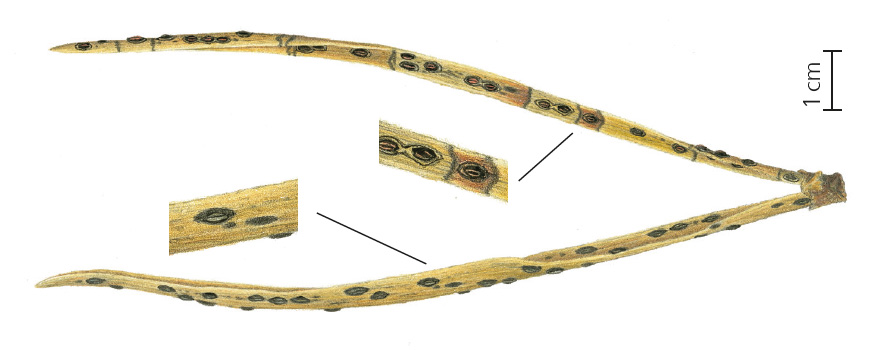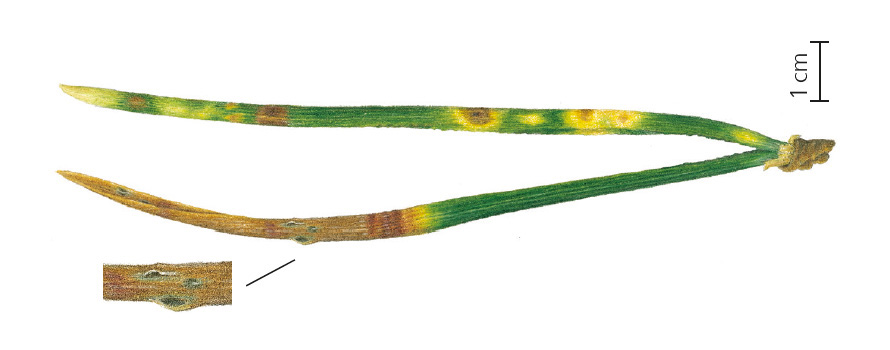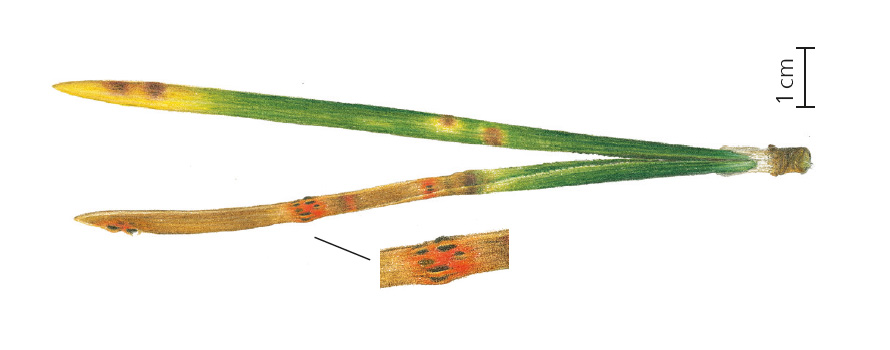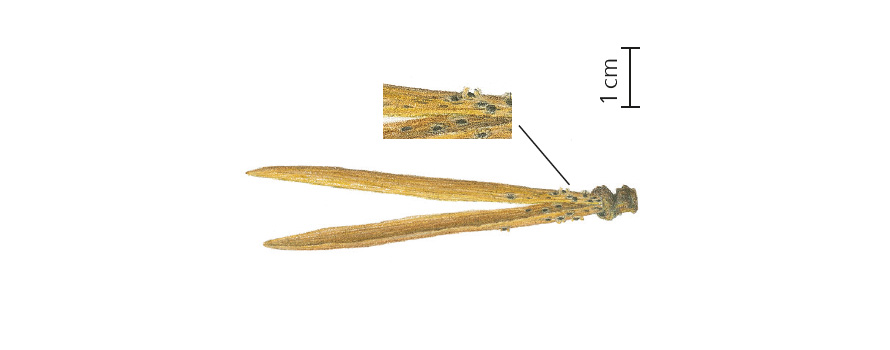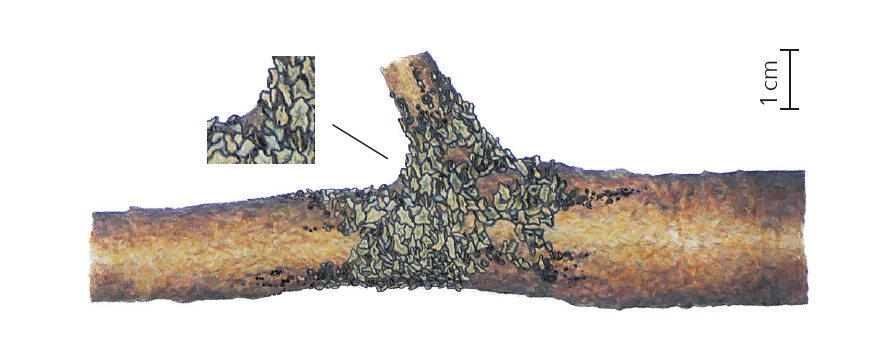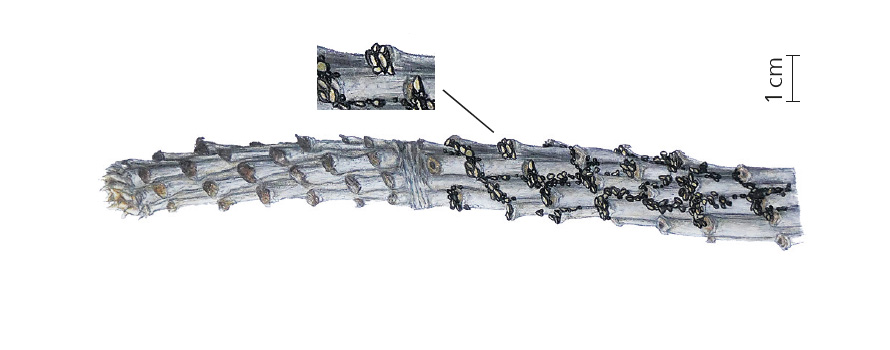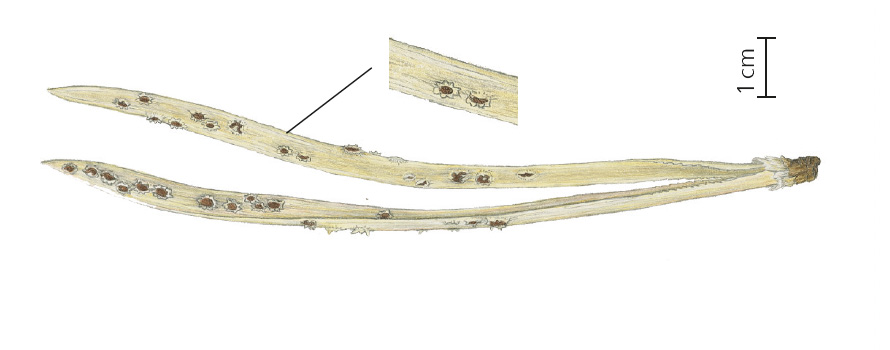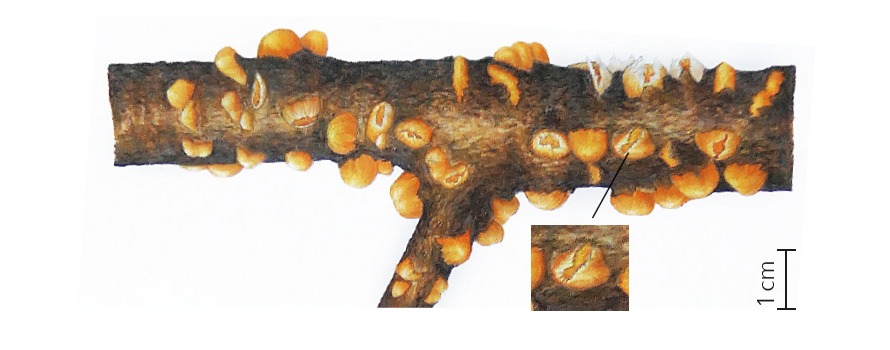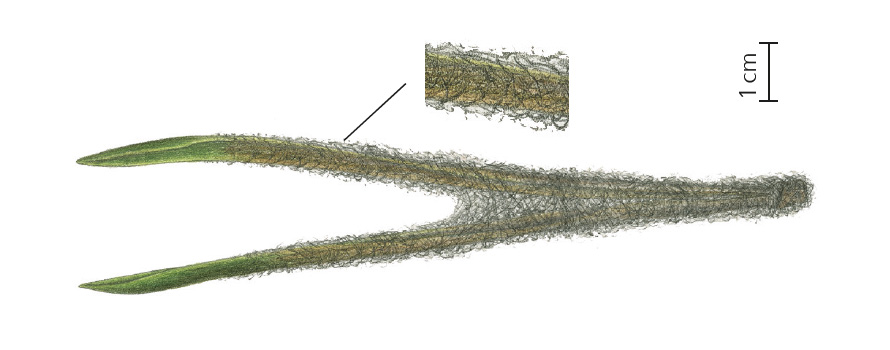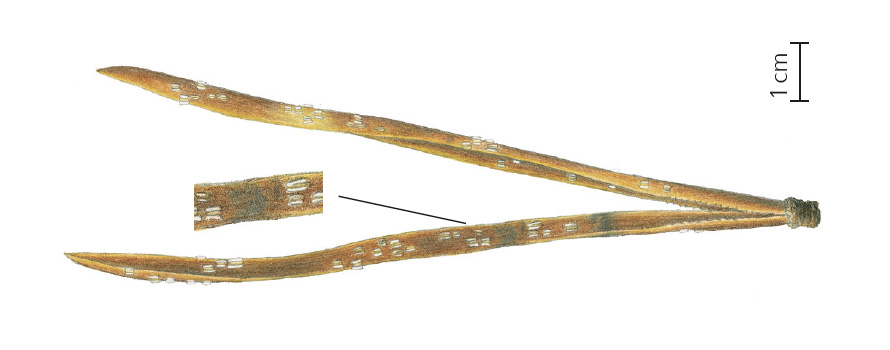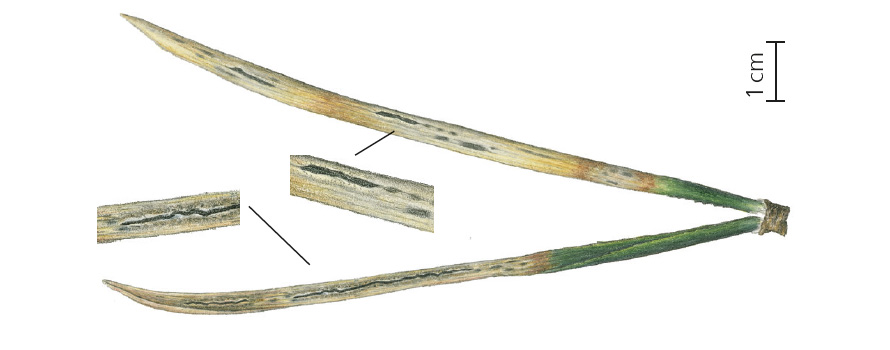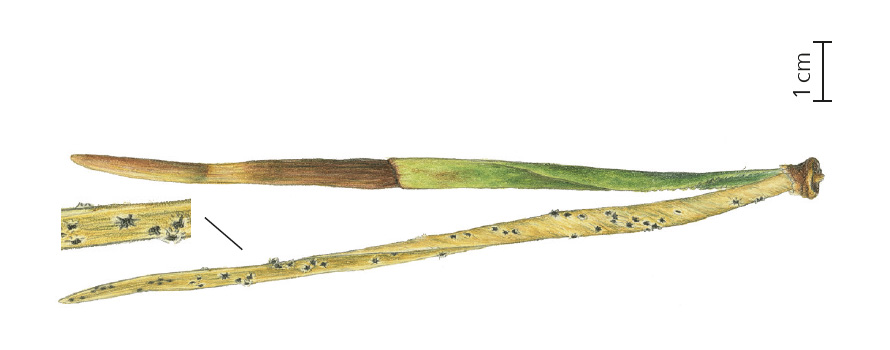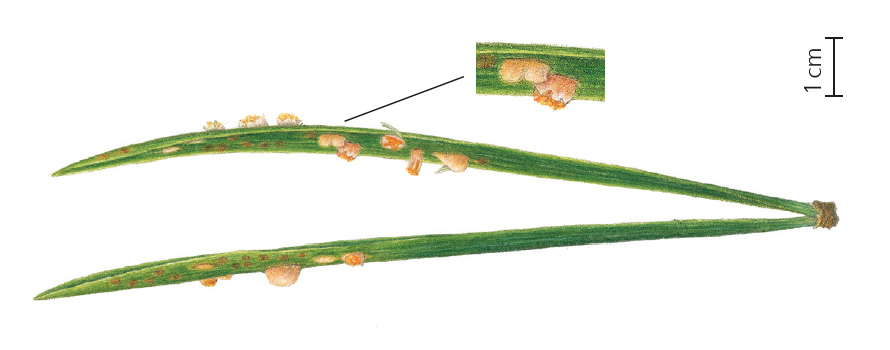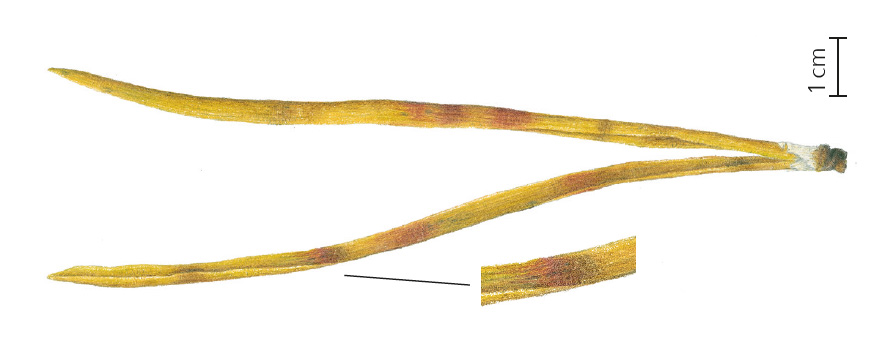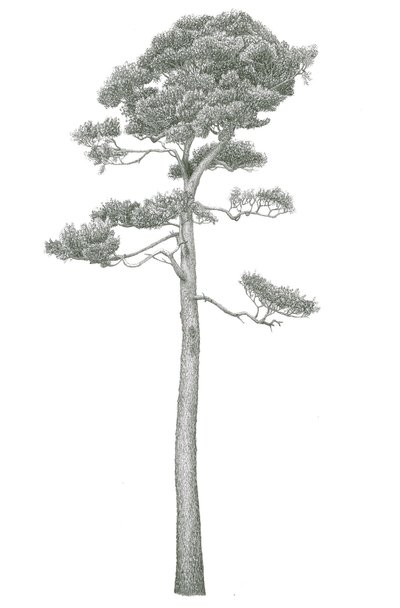
Fig. 1. Mature Scots pine (Pinus sylvestris) with a healthy appearance. Drawing: Vivanne Dubach.
Pine trees are an integral part of the forest landscape across Switzerland. In recent years, they have come under increasing pressure, not least due to new fungal diseases that have been introduced from abroad. Needle and shoot diseases play a major role for pine health.
When the appearance (habitus) of an infested pine changes, the tree attracts attention. Needle and shoot diseases are clearly visible and thus easily change the appearance of the tree. Pines in particular are susceptible to many such diseases, also in comparison with other conifers such as Norway spruce (Picea abies)and silver fir (Abies alba). This is also reflected by the comparatively high level of attention devoted to the pine tree both in research and in the advisory activities of the Swiss Forest Protection Group.
Needle diseases not only change the appearance of the tree, however. They can also weaken the tree, and thus increase its susceptibility to other biotic and abiotic influences. Conversely, biotic and abiotic stress factors make a tree susceptible to infection with needle disease: the weaker the tree, the more easily additional infections occur. Examples of abiotic stress factors include drought, hail or sudden waterlogging. An example of a biotic damaging influence is the infection with a root pathogen such as the honey fungi Armillaria, to which Scots pine (Pinus sylvestris) is particularly susceptible.
Frequency and distribution of Swiss pine species
Pines make up about 4.7 % of trees in the Swiss forest (stem count Swiss National Forest Inventory. According to the fourth Swiss National Forest Inventory, the Scots pine (Pinus sylvestris) is the most common forest species, accounting for 2.3 % of the total forest area in Switzerland, followed by the Swiss mountain pine (Pinus mugo, 1.2 %), the stone pine (Pinus cembra, 1.2 %), the black pine (Pinus nigra, 0.04 %), and other, non-native pine species (0.01 %).
Fig. 2. Modelled distribution areas of Swiss pine species from the MoGLi project (Modelling of shrub species LFI), based on records of the National Forest Inventory LFI. Data were pooled at the community level (B. A. Augustinus 2021). Black pine is not part of this dataset, as it hardly occurs in the forest.
The pine is a pioneer tree species. At lower altitudes, it usually disappears from the stand as the forest develops if it is not silviculturally promoted, due to its need for light. Pines therefore often occur in mixed stands, or they are displaced by competition on to dry, shallow or very moist extreme sites (ETH 1995). Scots pine, mountain pine and stone pine in particular are able to survive on difficult sites. In some areas, pines also form whole stands (e.g. the Swiss stone pine forests of the subalpine vegetation zone; the Swiss mountain pines of upland moors), and are thus essential for forest functions to be delivered (e.g. protection against rockfall and soil erosion in particular).
Importance of pine diseases
The Swiss Forest Protection Group has been documenting diseases affecting Swiss tree species since 1984. For some years now, pines in Switzerland have been increasingly affected by two “new” needle diseases: the red band needle blight, caused by the fungi Dothistroma septosporum and Dothistroma pini, and the brown spot needle blight, caused by Lecanosticta acicola. As both diseases can cause great damage to pines, they are classified as “particularly dangerous organisms” (“BgSO” [Swiss plant protection ordinance]). Since 2020, they have been considered to be “regulated non-quarantine organisms” (“GNQO”; PGesV-WBF-UVEK, SR 916.201 [under the Swiss plant protection ordinance]). To keep an eye on the damage potential and spread of these newcomers, the Swiss Forest Protection Group has been monitoring the diseases since 2009. In the course of these activities, numerous other needle diseases have been detected.
Portraits of needle and shoot diseases of pines
Detailed descriptions of these needle and shoot diseases on Scots pines can be found in the original publication:
- Lophodermium needle cast (L. seditiosum und L. pinastri)
- Brown spot needle blight (Lecanosticta acicola)
- Red band needle blight (Dothistroma spp.)
- Diplodia pine tip/shoot blight (Diplodia sapinea)
- Cenangium dieback (Cenangium ferruginosum)
- Scleroderris dieback / Brunchorstia dieback (Gremeniella abietina)
- Snow blight (Gremmenia infestans)
- Pine blister rust (Cronartium pini)
- Black snow mould (Herpotrichia pinetorum)
- Cyclaneusma needle cast (Cyclaneusma minus)
- Sydowia dieback of pine (Lophodermella sulcigena)
- Sydowia dieback of pine (Sydowia polyspora)
- Pine needle rust (Coleosporium tussilaginis)
Physiological needle blight is a natural process resulting from needle ageing, and one that every needle goes through. Accordingly, it is mainly older needle generations that are affected. Although it is not a disease, the phenomenon is listed here for the sake of completeness.
The most common fungi on the different species of pine
Cenangium shoot dieback (C. ferruginosum)and Scleroderris shoot dieback, also known as Scleroderris canker (Gremmeniella abietina), were the diseases most frequently found on needles and shoots of the stone pine (Fig. 3, Swiss stone pine). Also common were snow blight (Phacidium infestans)and physiological needle blight (natural ageing of the needles, not a fungal disease). The latter is not surprising, since all needles die after a few years. Physiological needle blight (PNB) in principle thus affects all pines. Damage of Swiss stone pine caused by the red band needle blight (Dothistroma spp.) originates in urban areas. As stone pines have relatively thin needles, symptoms of red band needle blight are sometimes more difficult to see. It is thus more likely to be detected in gardens than in the forest. Brown spot needle blight (Lecanosticta acicola) has not yet been found on Swiss stone pine.
Of all the pine species described here, mountain pine is most affected by brown spot needle blight (Fig. 3, mountain pine). On mountain pine, these two imported diseases, the redband needle blight and brown spot needle blight, together account for more than 75 % of the observed infestations of mountain pine. The third most common condition observed was physiological needle blight.
There are clear differences between black pine and the other pine species (Fig. 3, black pine); in black pine, damage caused by Diplodia shoot dieback (D. sapinea) dominates. Red band needle blight is the second most common disease affecting this species, but occurs much less frequently. All other pathogens described here are responsible for only a small proportion of the damage reported on black pine.
On the most common Swiss pine species, the Scots pine, red band needle blight is the most frequently recorded cause of damage, closely followed by Diplodia shoot dieback (Fig. 3, Scots pine). Cenangium dieback also occurs frequently on Scots pine, as does physiological needle blight.
Fig. 3. Distribution of the most frequently observed needle and shoot diseases among the different pine species. Only the pathogens described in this leaflet were considered for these evaluations. Data for which the pine species was not precisely specified as well as data from the survey were not included in this analysis. n = number of database entries.
Source
Detailed descriptions of these needle and shoot diseases on Scots pines and literature references can be found in the original publication.
You can order the printed WSL fact sheet Needle and shoot diseases of Scots pine free of charge from WSL.
WSL e-shop
Zürcherstrasse 111
CH-8903 Birmensdorf
e-shop@wsl.ch

